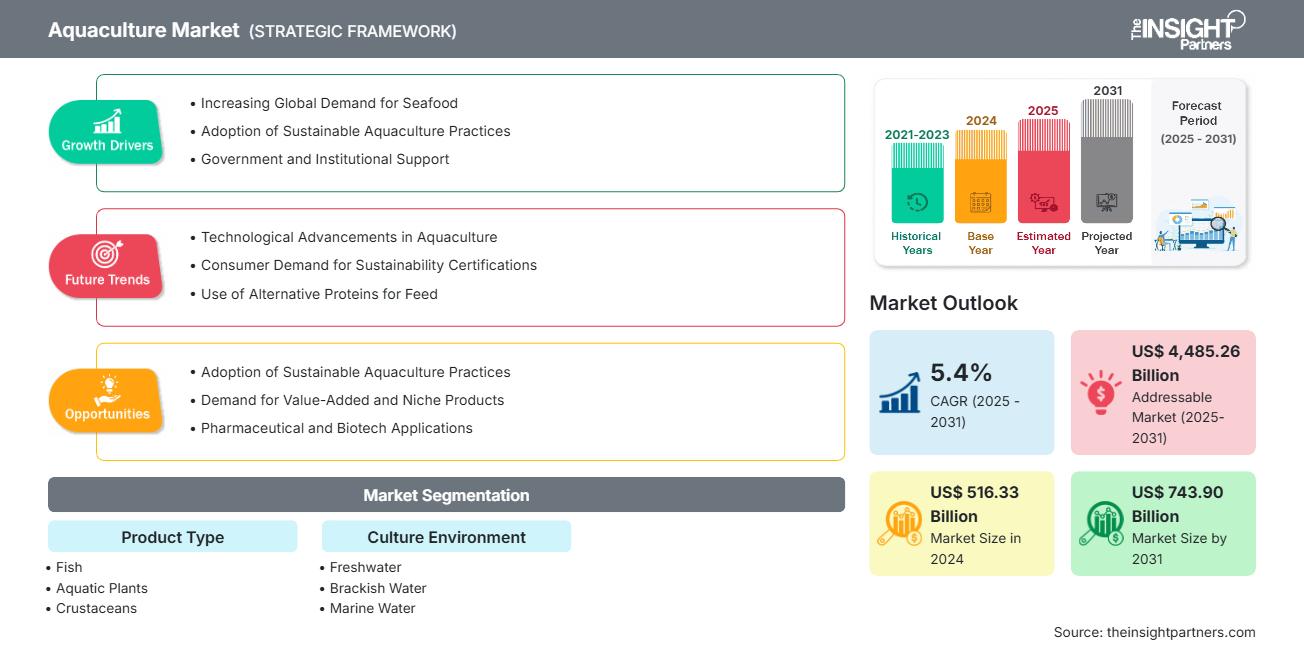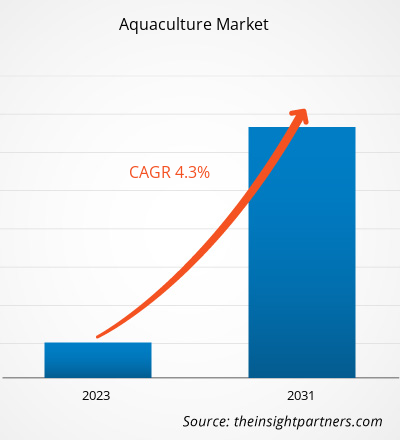世界の水産養殖市場規模は、2024年の5,163.3億米ドルから2031年には7,439億米ドルに達すると予測されています。市場は2025年から 2031年の間に5.4%のCAGRを記録すると予想されています。
世界の養殖市場分析
水産養殖市場は、高タンパク質食品への世界的な需要の高まり、天然資源の乱獲、そして養殖技術の進歩によって牽引されています。持続可能性が重要な焦点となる中、養殖は環境への影響を抑えながら水産物の需要を満たす機会を提供します。循環型養殖システム(RAS)や改良された養殖技術などの革新は、収量と効率を向上させます。さらに、新興国における投資の増加と政府の好ましい政策は、成長の有望な環境を生み出し、水産養殖を将来の食料安全保障に不可欠な要素として位置付けています。
世界の養殖市場の概要
世界の水産養殖市場は、水産物需要の高まり、乱獲への懸念、そして養殖技術の進歩に牽引され、力強い成長を遂げています。2024年には3,000億米ドルを超える市場規模に達すると予測されており、高タンパク質食の消費増加と持続可能な農業慣行の普及により、着実な拡大が見込まれています。この業界はアジア太平洋地域が主流を占めており、中でも中国が最大の生産国となっています。主要分野は淡水養殖、海水養殖、汽水養殖で、サケ、エビ、ティラピアなどの魚種に重点が置かれています。飼料、病害防除、アクアポニックスにおけるイノベーションは生産性をさらに向上させ、水産養殖は世界の食料安全保障と経済発展にとって不可欠な要素となっています。
このレポートの一部、国レベルの分析、Excelデータパックなど、あらゆるレポートを無料でカスタマイズできます。また、スタートアップや大学向けのお得なオファーや割引もご利用いただけます。
水産養殖市場:戦略的洞察

-
このレポートの主要な市場動向を入手してください。この無料サンプルには、市場動向から見積もりや予測に至るまでのデータ分析が含まれます。
世界の水産養殖市場の推進要因と機会
市場の推進要因:
-
世界的な水産物需要の高まり
人口増加と健康志向の食生活により、魚介類の消費量が増加しています。 -
野生漁業の過剰搾取
野生魚資源の減少により、持続可能な水産養殖への世界的な移行が加速しています。 -
技術の進歩
育種、水質管理、病気対策における革新により、収穫量が向上します。 -
政府の支援と補助金
多くの国々が有利な政策や資金援助を通じて水産養殖を推進しています。 -
持続可能で環境に優しい実践
循環型養殖システム(RAS)と統合型アクアポニックスの成長。 -
発展途上地域への進出
アフリカ、ラテンアメリカ、東南アジアの新興市場には、未開拓の可能性があります。
市場機会:
-
持続可能な養殖システムの拡大
循環型養殖システム(RAS)や統合型多栄養段階養殖(IMTA)などの環境に優しい方法の成長。 -
植物由来飼料および代替飼料の需要増加
藻類、昆虫、大豆ベースの飼料を使用することで、環境への影響と飼料コストを削減する機会 -
機能性およびオーガニックシーフードの成長
オーガニック、抗生物質不使用、付加価値のあるシーフード製品に対する消費者の関心が高まっています。 -
新興市場の発展
アフリカ、東南アジア、ラテンアメリカにおける投資とインフラの増加。 -
商業・ホスピタリティセクターの成長
ホテル、レストラン、食品加工業界では厳格な害虫駆除が求められており、サービスプロバイダーにとって成長の道が開かれています。
-
新種・新製品への拡大
高価値または新種の魚類(例:ナマコ、観賞魚)および海洋バイオ製品(例:コラーゲン、オメガ 3)の養殖。
世界の水産養殖市場レポートのセグメンテーション分析
世界の水産養殖市場は、その仕組み、成長の可能性、そして最新のトレンドをより明確に把握するために、様々なセグメントに分割されています。以下は、ほとんどの業界レポートで使用されている標準的なセグメント分けのアプローチです。
製品タイプ別:
-
魚
淡水または海洋システムを使用して、人間の食用のために養殖されており、タンパク質とオメガ 3 脂肪酸が豊富です。-
鮭
冷水網囲いまたは陸上システムで養殖され、高い市場価値と栄養分で高く評価されています。 -
鮭
主に若いうちに捕獲された後、海上で飼育または養殖され、寿司や輸出市場で高く評価されています。 -
タラ
冷たい海洋環境で養殖され、白くてフレーク状の肉を持ち、切り身や加工食品に使用されることで知られています。 -
その他
ティラピアやナマズなどの種は、手頃な価格で持続可能なタンパク質を得るために広く栽培されています。
-
-
水生植物
これには、食品、化粧品、バイオ燃料、医薬品用に栽培される海藻や藻類が含まれます。 -
甲殻類
エビやカニは池や水槽で養殖されており、世界中の料理や輸出貿易で非常に人気があります。 -
軟体動物
カキ、ムール貝、ハマグリは、食用や真珠生産のためにロープや海底で養殖されることが多いです。 -
その他
これらにはウナギ、カエル、観賞魚などが含まれており、ニッチ市場や水族館業界向けに飼育されています。
文化環境別:
-
淡水
ティラピア、コイ、ナマズなどの魚種の川、池、水槽での養殖は、コストが低く、入手しやすいことから広く利用されています。 -
汽水
河口や沿岸の池などのわずかに塩分濃度の高い環境を利用して、淡水と海洋の特性をバランスさせながらエビやミルクフィッシュなどの種を養殖します。 -
海水
鮭、マグロ、スズキなどの海水魚を海洋ケージ、網かご、沖合養殖場で養殖しており、高価値の魚介類生産に最適です。
地理別:
- 北米
- ヨーロッパ
- アジア太平洋
- 中東およびアフリカ
- 南米と中央アメリカ
アジア太平洋地域の水産養殖市場は、最も急速な成長が見込まれています。アジア太平洋地域の水産養殖市場を牽引する主な要因は、高い生産量、堅調な水産物需要、そして良好な養殖条件です。
養殖市場の地域別洞察
予測期間を通じて水産養殖市場に影響を与える地域的な動向と要因は、The Insight Partnersのアナリストによって徹底的に解説されています。このセクションでは、北米、ヨーロッパ、アジア太平洋、中東・アフリカ、中南米における水産養殖市場のセグメントと地域についても解説しています。
水産養殖市場レポートの範囲
| レポート属性 | 詳細 |
|---|---|
| 2024年の市場規模 | 5,163億3,000万米ドル |
| 2031年までの市場規模 | 7,439億米ドル |
| 世界のCAGR(2025年~2031年) | 5.4% |
| 履歴データ | 2021-2023 |
| 予測期間 | 2025~2031年 |
| 対象セグメント |
製品タイプ別
|
| 対象地域と国 |
北米
|
| 市場リーダーと主要企業の概要 |
|
水産養殖市場のプレーヤー密度:ビジネスダイナミクスへの影響を理解する
水産養殖市場は、消費者の嗜好の変化、技術の進歩、製品の利点に対する認知度の高まりといった要因によるエンドユーザーの需要増加に牽引され、急速に成長しています。需要の増加に伴い、企業は製品ラインナップの拡充、消費者ニーズへの対応のための革新、そして新たなトレンドの活用を進めており、これが市場の成長をさらに加速させています。

- 水産養殖市場のトップキープレーヤーの概要を入手
地域別世界水産養殖市場シェア分析
アジア太平洋地域は今後数年間で急速な成長が見込まれています。アジア太平洋地域の新興市場には、養殖業者にとって事業拡大の未開拓の機会が数多く存在します。
水産養殖市場の成長は地域によって異なります。これは、世界的な水産物需要の増加、天然魚類の枯渇、養殖方法の技術進歩、政府の政策や補助金、健康志向とタンパク質消費の高まり、発展途上地域での市場拡大、持続可能で環境に配慮した慣行の導入といった要因によるものです。以下は、地域別の市場シェアと動向の概要です。
1. 北米
-
市場占有率:
持続可能な慣行への投資の増加による中程度のシェア -
主な推進要因:
- 高品質で追跡可能な水産物の需要
- 循環型養殖システム(RAS)における技術革新
- 政府の規制と認証による支援
-
トレンド:
陸上サーモン養殖と植物由来飼料代替品の成長
2. ヨーロッパ
-
市場占有率:
着実な進歩を遂げる成長市場 -
主な推進要因:
- 侵略的外来種の脅威
- 公衆衛生上の懸念
- 気候変動の影響
-
トレンド:
環境に優しい生物農薬とインテリジェント害虫駆除の増加
3. アジア太平洋
-
市場占有率:
世界最大の生産量を誇る最大の市場 -
主な推進要因:
- 魚介類の消費量が多い
- 養殖業への政府補助金と投資
- 沿岸養殖開発
-
トレンド:
養殖の強化、デジタル技術の統合、輸出志向型生産への重点化
4. 中東およびアフリカ
-
市場占有率:
高い成長の可能性を秘めた新興市場 -
主な推進要因:
- 水不足が持続可能な取り組みを推進
- 食料安全保障の取り組み
- 養殖インフラへの政府投資
-
トレンド:
海洋環境における砂漠養殖とケージ養殖の導入
5. 南米と中央アメリカ
-
市場占有率:
健康意識の高まりにより大きなシェアを獲得 -
主な推進要因:
- タンパク質を豊富に含む食事への需要の高まり
- 沿岸および内陸養殖の拡大
- 輸出志向型水産養殖に対する政府の支援
-
トレンド:
持続可能な養殖方法の採用、ティラピアとエビの養殖の成長、病気に強い種への投資の増加
世界の水産養殖市場のプレーヤー密度:ビジネスダイナミクスへの影響を理解する
高い市場密度と競争
JBS SA、Mowi ASA、Blue Ridge Aquaculture Inc、Thai Union Group PCLといった既存企業の存在により、競争は熾烈です。Bakkafrost、Danish Salmon、Mowi ASAといった地域密着型かつニッチな供給業者も、各地域で競争を激化させています。
この高いレベルの競争により、企業は次のようなものを提供して差別化を図ろうとしています。
- 循環型養殖システム(RAS)の利用
- AIとIoTベースの監視と自動化
- 遺伝的改良と育種技術
機会と戦略的動き
- 持続可能で環境に優しい実践。
- 高価値種の多様化。
- 循環型養殖システム(RAS)に焦点を当てる
- すぐに食べられる、または付加価値のあるシーフードの導入
世界の水産養殖市場で事業を展開している主要企業は次のとおりです。
- JBS SA
- モウィASA
- ブルーリッジ・アクアカルチャー社
- タイユニオングループPCL
- バッカフロスト
- クック・アクアカルチャー社
- デンマーク産サーモン
- リロイシーフードグループASA
- ストルト・ニールセン株式会社
- セルマクグループAS
免責事項:上記の企業は、特定の順序でランク付けされているわけではありません。
調査の過程で分析した他の企業:
- グリーグシーフードASA
- サルマール ASA
- ニレウス水産養殖SA
- カーギルアクアニュートリション
- マルハニチロ株式会社
- 日本水産株式会社(ニッスイ)
- ユニマグループ
- アメリカのアワビ養殖場
- ファラロン水産養殖(南アフリカ)
- エンプレサス アクアチリ SA
- マルチエクスポートフーズ
- シーウォッチインターナショナル株式会社
- セロンダ水産養殖SA
- トライデントシーフード
- ヌエバ・ペスカノバ・グループ
- ヒューオン水産養殖グループ
- オーシャンアクアファームズAS
- アクア.cl
- テキサス水産養殖株式会社
- 国際魚養殖ホールディングス(アスマク)
世界の養殖市場のニュースと最近の動向
-
欧州委員会、EU全域で水産養殖キャンペーンを開始
EU委員のコスタス・カディス氏は、EU内での魚、貝類、藻類の養殖を促進することを目的に、加盟国と水産養殖諮問委員会の間で認識と理解を高めることに重点を置いたEU全体の水産養殖キャンペーンを開始する。 -
インドとモルディブ、漁業と養殖業の協力強化に向けた覚書を締結
インドとモルディブは、漁業と養殖業における二国間関係を強化するための覚書(MoU)に署名しました。これは、持続可能な海洋資源開発に向けた重要な一歩となります。この合意は、ナレンドラ・モディ首相のモルディブ国賓訪問中に正式に締結されました。 -
ブラジルフィッシュとCATがブラジルで初の遺伝子編集ティラピアを導入
ブラジル魚類協会と水産養殖技術センター(CAT)は、ブラジルで初となる遺伝子編集ティラピアを開発しました。繁殖効率を20年から1年に短縮することで、生産性と収量の向上を目指しています。この取り組みでは、生殖誘導と体外受精試験を実施し、成長、収量、飼料効率の向上を目指します。最初の遺伝子編集魚は現在、パフォーマンスとゲノム評価の準備が整っています。
世界の水産養殖市場レポートの対象範囲と成果物
「世界の水産養殖市場の規模と予測(2021〜2031年)」レポートでは、以下の分野を網羅した市場の詳細な分析を提供しています。
- 対象範囲に含まれるすべての主要市場セグメントについて、世界、地域、国レベルでの水産養殖市場の規模と予測
- 世界の水産養殖市場の動向、および推進要因、制約、主要な機会などの市場動向
- 詳細なポーター分析とSWOT分析
- 主要な市場動向、世界および地域の枠組み、主要プレーヤー、規制、最近の市場動向を網羅した世界の水産養殖市場分析
- 市場集中、ヒートマップ分析、主要プレーヤー、世界の水産養殖市場の最近の動向を網羅した業界の展望と競争分析
- 詳細な企業プロフィール
- 過去2年間の分析、基準年、CAGRによる予測(7年間)
- PEST分析とSWOT分析
- 市場規模価値/数量 - 世界、地域、国
- 業界と競争環境
- Excel データセット
最新レポート
お客様の声
購入理由
- 情報に基づいた意思決定
- 市場動向の理解
- 競合分析
- 顧客インサイト
- 市場予測
- リスク軽減
- 戦略計画
- 投資の正当性
- 新興市場の特定
- マーケティング戦略の強化
- 業務効率の向上
- 規制動向への対応






















 無料サンプルを入手 - 養殖市場
無料サンプルを入手 - 養殖市場